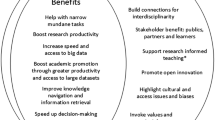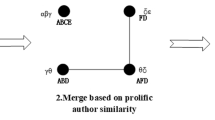Abstract
“Open science,” where researchers share and publish every element of their research process in addition to the final results, can foster novel ways of collaboration among researchers and has the potential to spontaneously create new virtual research collaborations. Based on scientific interest, these new virtual research collaborations can cut across traditional boundaries such as institutions and organizations. Advances in technology allow for software tools that can be used by different research groups and institutions to build and support virtual collaborations and infuse open science. This paper describes Talkoot, a software toolkit designed and developed by the authors to provide Earth Science researchers a ready-to-use knowledge management environment and an online platform for collaboration. Talkoot allows Earth Science researchers a means to systematically gather, tag and share their data, analysis workflows and research notes. These Talkoot features are designed to foster rapid knowledge sharing within a virtual community. Talkoot can be utilized by small to medium sized groups and research centers, as well as large enterprises such a national laboratories and federal agencies.



Similar content being viewed by others
References
Bernholdt D, Bharathi S, Brown D, Chanchio K, Chen M, Chervenak A, Cinquini L, Drach B, Foster I, Fox P, Garcia J, Kesselman C, Markel R, Middleton D, Nefedova V, Pouchard L, Shoshani A, Sim A, Strand G, and Williams D (2005) The earth system grid: supporting the next generation of climate modeling research Proceedings of IEEE 93 (3)
Bos N, Zimmerman A, Olson J, Yew J, Yerkie J, Dahl E et al (2007) From shared databases to communities of practice: a taxonomy of collaboratories. J Comp-Mediated Commun 12
Christie M, Marru S (2007) The LEAD portal: a TeraGrid gateway and application service architecture. J Concurr Comput: Pract Experience Sci Gateways—Common Commun Interfaces Grid Resour 19 (6)
Cottey A (2000) Information technology - the key to taking open science forward. Scientists for Global Responsibility
Das S, Green T, Weitzman L, Lewis-Bowen A, and Clark T (2008) Linked data in a scientific collaboration framework. In 17th International World Wide Web Conference (WWW2008). Beijing, China
De Roure D, Goble C, Aleksejevs S, Bechhofer S, Bhagat J, Cruickshank D, Fisher P, Hull D, Michaelides D, Newman D, Procter R, Lin Y, Poschen M (2010) Towards open science: the myExperiment approach. Concurr Comput: Pract Experience 22(17):2335–2353
Drupal. Drupal - Open source content management platform 2009 [cited September 29, 2009]. Available from www.drupal.org
Gruber T (2008) Collective knowledge systems: where the Social Web meets the Semantic Web. Web Semantics: Science, Services and Agents on the World Wide Web
Howe J (2006) The rise of crowdsourcing. Wired, June
Joomla. Joomla! - dynamic portal engine and content management system 2009 [cited September 29, 2009]. Available from http://www.joomla.org/
Klimeck G, McLennan M, Brophy SP, Adams GB, Lundstrom MS (2008) nanoHUB.org: advancing education and research in nanotechnology. Comput Sci Eng 10:5
Leadbeater C (2008) We-think - mass innovation, not mass production: profile, London
Martin JH, Fitzwater SE (1998) Iron deficiency limits phytoplankton growth in the north-east Pacific subarctic. Nature 331(341–343)
McLennan M, Kennell R (2010) HUBzero: a platform for dissemination and collaboration in computational science and engineering. Comput Sci Eng 12(2):48–53
MODAPS (2011) MODIS Adaptive Processing System (MODAPS) Services 2011 [cited 2011]. Available from http://modaps.nascom.nasa.gov/services/
Nair US, Weger RC, Kuo KS, Welch RM (1998) Clustering, randomness, and regularity in cloud fields 5. The nature of regular cumulus cloud fields. J Geophys Res 103:11,363–11,380
OpenSearch (2011) Open Search 2011 [cited 2011]. Available from http://www.opensearch.org/Home
Rheingold H (2002) Smart mobs: the next social revolution: Perseus Books
Search. 2011. Mirador Search 2011 [cited 2011]. Available from http://mirador.gsfc.nasa.gov/
Surowiecki J (2004) The wisdom of crowds: why the many are smarter than the few and how collective wisdom shapes business, economies, societies and nations: little brown
Tapscott D, and Williams AD (2006) Wikinomics: how mass collaboration changes everything: portfolio hardcover
Teragrid. TeraGrid - open scientific discovery infrastructure 2011 cited. Available from https://www.teragrid.org/
Tero H, Juhana K, Kari AH, Petri K, Timo H, Pirjo N (2008) Tutkimusparvi: the open research swarm in Finland. In Proceedings of the 12th international conference on Entertainment and media in the ubiquitous era. Tampere, Finland: ACM
Wilkins-Diehr N, Gannon D, Klimeck G, Oster S, Pamidighantam S (2008) TeraGrid science gateways and their impact on science. Computer 41(11):32–41
Acknowledgements
This work has been funded by NASA ACCESS Grant # NNX08AT90A.
Author information
Authors and Affiliations
Corresponding author
Additional information
Communicated by H. A. Babaie
Rights and permissions
About this article
Cite this article
Ramachandran, R., Maskey, M., Kulkarni, A. et al. Talkoot: software tool to create collaboratories for earth science. Earth Sci Inform 5, 33–41 (2012). https://doi.org/10.1007/s12145-012-0094-y
Received:
Accepted:
Published:
Issue Date:
DOI: https://doi.org/10.1007/s12145-012-0094-y




